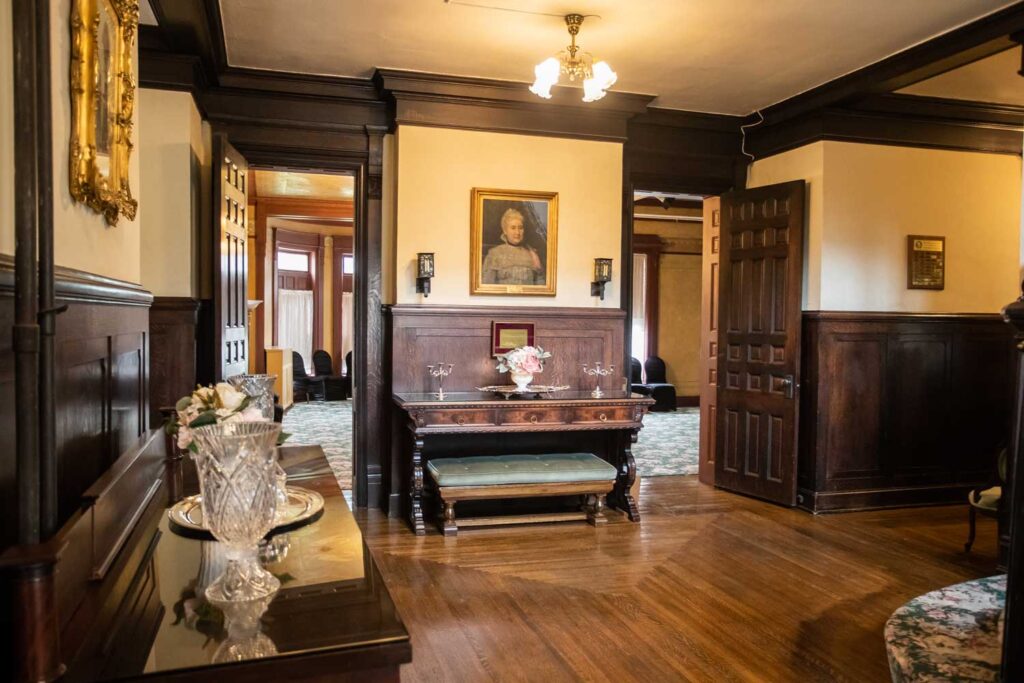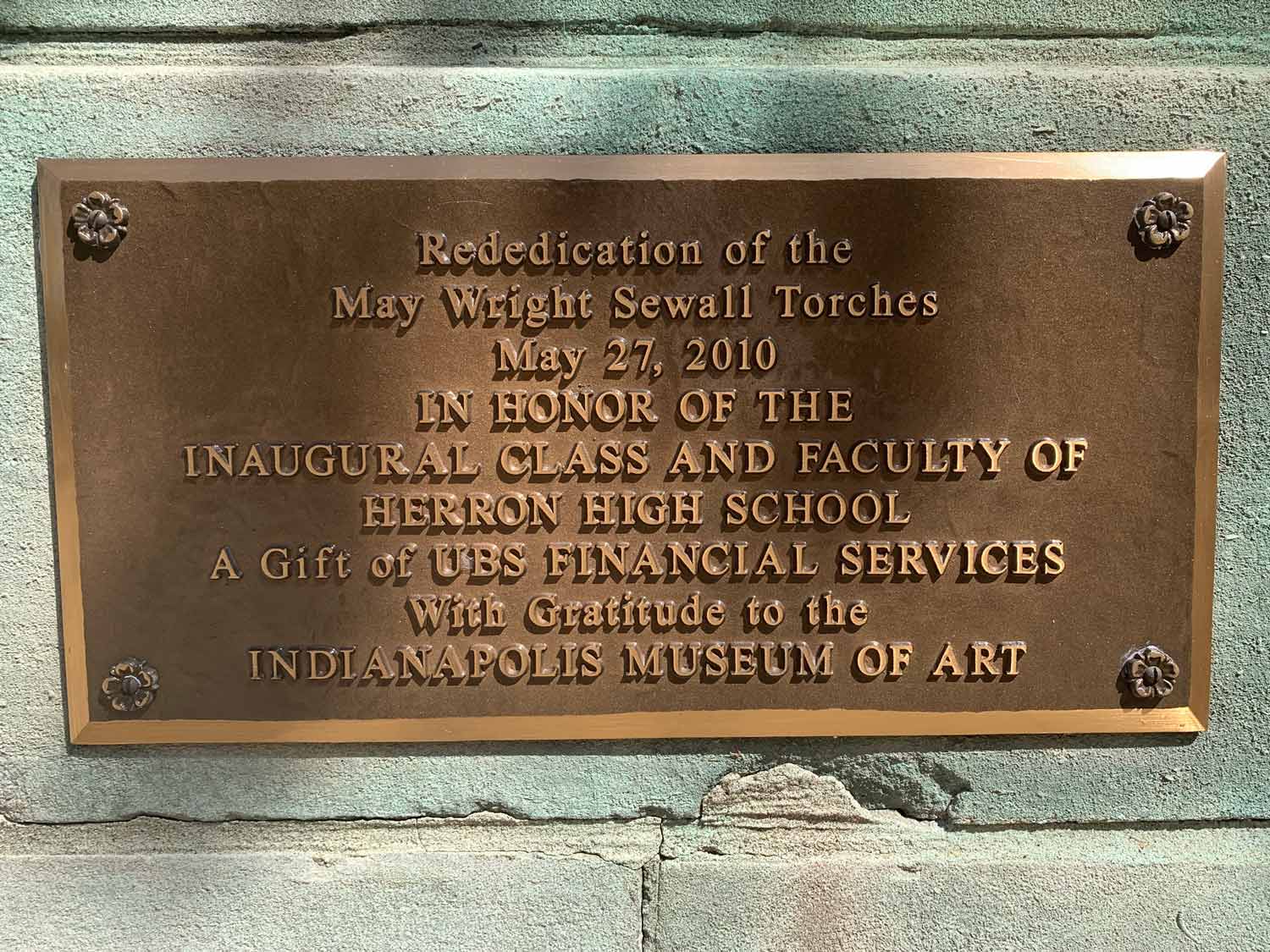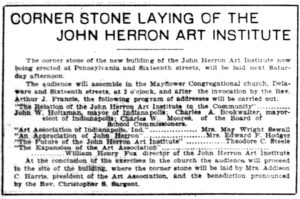Theodore Clement Steele, American, 1847–1926
1899
Oil on canvas
69.85 cm x 57.15 cm | 27 1/2 in x 22 1/2 in
Framed: 85.09 cm x 72.39 cm | 33 1/2 in x 28 1/2 in
Original Lieber frame
Signed and dated high lower right
With permission, The Indianapolis Propylaeum
May Eliza Wright Sewall (1844 -1920) earned a prominent place in Indiana history as an American reformer, making both national and international impact during her selfless work in politics, social movements and the arts in the late 19th and early 20th centuries. She was a friend of T.C. Steele and collaborated with him in creating the Art Association of Indianapolis, Indiana.
Sewall is perhaps best known for work in the women’s suffrage movement becoming involved at the national level and working with suffrage leader Susan B. Anthony. Sewall died at age 76, a month after the Nineteenth Amendment was ratified.
“By 1920, Sewall’s fame as a women’s rights activist, peace advocate, and spiritualist had spread so widely that she was one of the best known Hoosiers in the world.”¹
From modest beginnings as a teacher in a one-room Wisconsin school, she became one of the leading citizens of Indianapolis and founder-with her husband Theodore of the Girls’ Classical School of Indianapolis.
Sewall helped to form many of the city of Indianapolis’ enduring organizations: the Indianapolis Woman’s Club, the Indianapolis Propylaeum, the Contemporary Club and the Art Association of Indianapolis which has grown into the internationally-respected Indianapolis Museum of Art (Newfields).

Steele signed high lower right on this portrait – note how he has stacked his name and date with a large “T.C.” and “S” on Steele, and large date of 1899, and long “9’s”. 
Lieber Frame label on back 
May Wright Sewall portrait by T.C. Steele in the main hall, first floor of The Indianapolis Propylaeum.
She worked tirelessly on behalf of rights for women in the United States and around the world. She was sent to the Paris Exposition (Exposition Universelle 1900) by President McKinley to represent the United States. In 1915 she sailed to Europe on the Oscar II as a member of Henry Ford’s Peace Exposition to halt the First World War. Her work gave the women’s movement an international focus through her pioneering involvement with the International Council of Women and the American National Council of Women.⁴
May Wright Sewall was significant in bringing focus to the arts in Indianapolis, and was a charter member of the Art Association of Indianapolis.“
“The Art Association of Indianapolis was organized informally April 5, 1883, after an art lecture hosted by educator and women’s rights activist May Wright Sewall.”²
The Association organized formally May 7,1883 and incorporated October 11, 1883, more than 130 years ago. In 1883, May Wright Sewall, along with 17 other residents of the city, signed the articles of incorporation to fund the Art Association of Indianapolis.

“May Wright Sewall Torches” in front of Herron High School. They were returned to the property from Indianapolis Museum of Art on May 27, 2010. 
On bottom of each torch reads; “In Grateful Memory of May Wright Sewall In Whose Wise and Farseeing Thought Originated The Idea of An Art Association of Indianapolis” 
Rededication plaque in bronze, mounted on stone base on the eastern torch.
“Nothing is so cosmopolitan in its tendency as art; where it flourishes, the provincial spirit declines; sect and party lines become faint as it becomes dominant. The art spirit is by no means dominant in Indianapolis, but it is felt as a vital force.”³
May Wright Sewall
In 1895, the Art Association of Indianapolis received a $225,000 gift from the estate of real estate investor John Herron to build a permanent art gallery and school. This new building would be located on the property of the home and studio of T.C. Steele and his family, known at Tinker House and also as Talbott Place. This new building would be named the John Herron Art Institute, and would later become the Indianapolis Museum of Art (Newfields).
“I know I voice the intention of the Art Association and the director elected to do this work, when I say they expect to make the John Herron Art Institute a live force in this community. To do the work that is at hand and to plan so broadly that future growth will not be impeded.”
T.C. Steele
Remarks at cornerstone laying
Saturday, November 25, 1905

On November 20, 1906, the John Herron Art Institute formally opened its doors in a building designed by the Indianapolis architecture firm of Vonnegut & Bohn.
An Indiana Historical Marker exists to recognize May Wright Sewall’s significant contributions.
She is buried in Crown Hill Cemetery in Indianapolis, Indiana, Section 13, Plot 24.

¹ Stephens, Jane. May Wright Sewall: An Indiana Reformer. Indiana Magazine of History, 1982, Vol 78, Issue 4, December 1982. https://scholarworks.iu.edu/journals/index.php/imh/article/view/10416/14544
² Original Articles of Association of the Art Association of Indianapolis,” in Art Association of Indianapolis, Indiana: A Record (Indianapolis: Hollenbeck Press, 1906), 42, Indiana State Library.
³Newfields – A Place for Nature & the Arts – History https://discovernewfields.org/about/history
⁴Biographical Sketch of May Eliza Wright Sewall, Clifton J. Phillips in Notable American Women, 1607-1950, Volume III, ed. By Edward T. James, Janet Wilson James, and Paul S. Boyer. (Cambridge, MA; Harvard University Press 1971, pp. 269-71. https://documents.alexanderstreet.com/d/1009810364
5May Wright Sewall Papers, The Indianapolis Public Library, Digital Indy, http://www.digitalindy.org/cdm/landingpage/collection/mws

